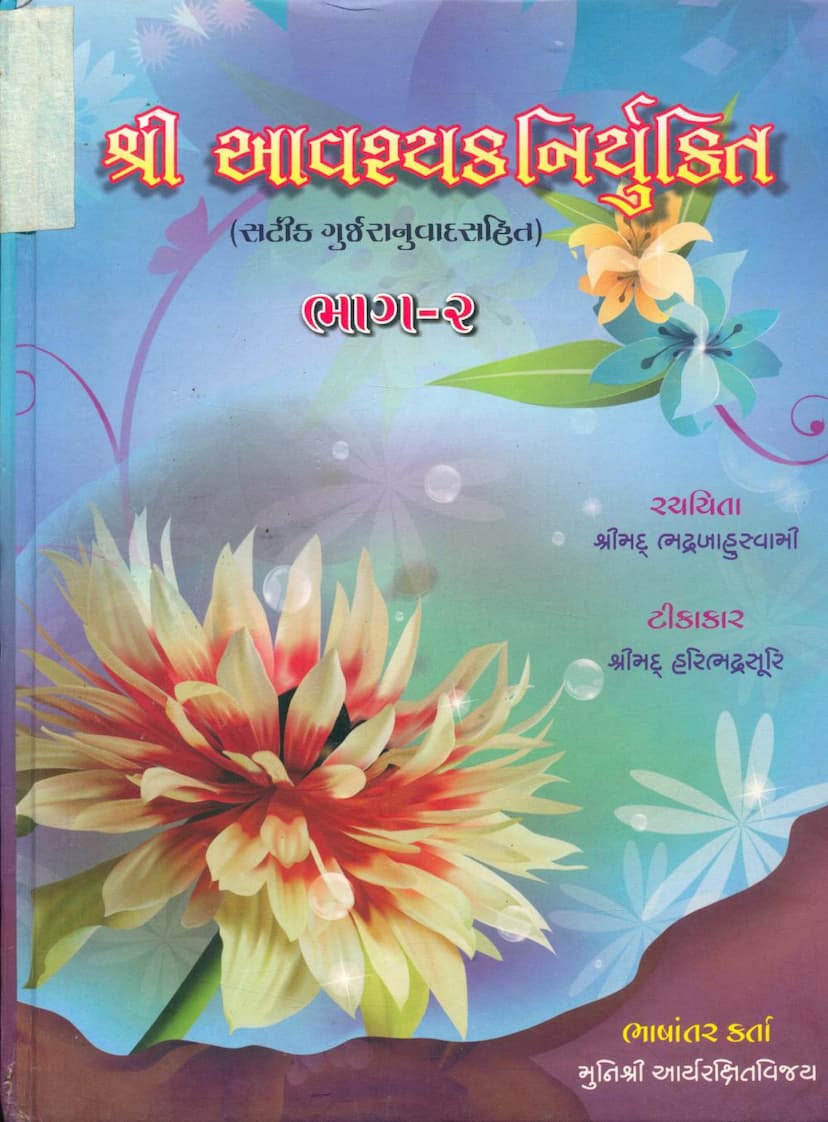Avashyak Niryukti Part 02
Added to library: September 1, 2025

Summary
Here is a comprehensive summary of the provided Jain text, "Avashyak Niryukti Part 02" by Aryarakshitvijay, based on the provided pages:
Book Title: Avashyak Niryukti Part 02 (Aushyak Niryukti Part 02) Author: Aryarakshitvijay Publisher: Vijay Premsuri Sanskrit Pathshala Original Work: Avashyak Sutra by Bhadrabahuswami, Commentary by Haribhadrasuri Gujarati Translation & Commentary: Aryarakshitvijay
Overall Context: This text is the second part of a Gujarati translation and commentary on the Avashyak Niryukti, which is a foundational Jain scripture dealing with essential daily observances. The translation and commentary are by Muni Aryarakshitvijay, presented with the blessing and inspiration of various prominent Jain Acharyas. The publication is by Shrimad Vijay Premsurishwarji Sanskrit Pathshala, Ahmedabad.
Key Information from the Provided Pages:
- Volume: Part 02, covering Niryukti verses 186-641.
- Lineage: The work is attributed to the esteemed Acharya Bhadrabahuswami (author of the Niryukti) and Acharya Haribhadrasuri (author of the commentary 'Shishyahrida'). The Gujarati translation is by Muni Aryarakshitvijay, who is guided by his gurus, Muni Jitrakshitvijay and Muni Chandrashekharvijay. The research and editing are by Muni Bhavyasundarvijay.
- Publisher & Location: Shrimad Vijay Premsurishwarji Sanskrit Pathshala, Tappovan Sanskarpith, Amiyapur, Ahmedabad, Gujarat.
- Content Focus: The text delves into the detailed explanations and meanings of the Avashyak Sutras. The provided pages specifically cover the initial sections of the Niryukti, focusing on the lives and deeds of the first Tirthankara, Lord Rishabhdev, and then progressing to other Tirthankaras, Chakravartis, Vasudevas, Baladevas, and their associated events. It also includes discussions on Jain philosophical concepts, rituals, and the methodology for studying Sanskrit commentaries.
- Purpose: The translation aims to make the profound meanings of the Avashyak Niryukti and its commentary accessible to a wider Gujarati-speaking audience, especially monks and nuns, encouraging them to engage with the original Sanskrit text as well.
Detailed Summary of Content Sections (based on the structure indicated in the "Vishayanukramanika" - Subject Index):
Part 02 (Verses 186-641) covers the following broad topics:
-
Lord Rishabhdev's Life (Niryukti 186-212):
- Birth, naming ceremony, growth.
- Inclusion of divine maidens in the birth ceremony.
- Establishment of lineage and prosperity.
- Details of the divine Abhishek ceremony performed by celestial beings.
- The significance of Rishabhdev's birth and the divine reception.
- The concept of 'Dravya' and 'Bhava' in Jainism, as it relates to understanding commentaries.
- The practice of 'Dravya-parihant' (abstinence from material things) and 'Bhava-parihant' (abstinence from internal passions).
-
Chronology and Ranks of Tirthankaras and Chakravartis:
- Details about Tirthankaras, their lineage, lifespan, bodily proportions, and birthplaces.
- Information about Chakravartis, their lineage, lifespan, and birthplaces.
- Details about Vasudevas and Baladevas, their lineage, lifespan, and birthplaces.
- The time intervals between Tirthankaras, Chakravartis, and Vasudevas.
-
Mata-Pita (Parents) and Cities:
- The names of the parents of various Tirthankaras, Chakravartis, and Vasudevas.
- The cities associated with their births and lives.
-
Tapasya (Austerities) and Kevala Gyana (Omniscience):
- The nature of austerities performed by Tirthankaras and their attainment of Kevala Gyana.
- The specific time and conditions under which Kevala Gyana was attained.
-
Upasargas (Afflictions/Harassments) and their Management:
- The text details various types of afflictions faced by Tirthankaras, particularly Lord Mahavir, and how they were overcome.
- The role of deities like Sangamadeva and their attempts to test the Tirthankaras.
- The text narrates the story of Sangamadeva's repeated attempts to disturb Lord Mahavir's penance and the Tirthankara's equanimity.
- The legend of the Goala (cowherd) and his actions against Lord Mahavir, and how the divine intervention of Indra and other celestial beings resolved the situations.
- The story of Chanda Kausika, the serpent, and its transformation.
- The tale of the Jaliya (Jaliya Brahman) and the incident with the three sisters (Ganga, Yamuna, Saraswati).
- The narrative of the merchant Dhanadeva and his cows, and the subsequent events leading to the formation of the 'Asthikagrama' village and the origin of the Shulapani Yaksha.
- The story of Kausika, the barber, and his interactions with Lord Mahavir.
- The detailed account of the celestial beings' involvement in the birth, upbringing, and divine reception of the Tirthankaras, including the erection of celestial pavilions and the distribution of alms.
-
The Process of Renunciation and Kevala Gyana:
- The text describes the intricate details of the Tirthankaras' renunciation, including the auspicious time, the types of austerities performed, and the process of attaining Kevala Gyana.
- The life events of Lord Rishabhdev, including his marriage, the birth of his children like Bharat and Bahubali, his reign, and eventual renunciation.
- The legend of Bharat Chakravarti's conquest of the Jambudvipa and his subsequent renunciation.
- The story of Bahubali's intense penance and attainment of Kevala Gyana.
-
Philosophical Discussions:
- The text engages in philosophical debates, particularly addressing the nature of the soul, karma, and liberation. It touches upon concepts like 'Anekanta' (non-absolutism) and the limitations of various philosophical viewpoints, including those that deny the existence of a soul or the efficacy of rituals.
- The commentary also explores the nature of reality, distinguishing between the eternal (Nitya) and the non-eternal (Anitya), and the role of knowledge (Jnana) in attaining liberation.
-
Methodology of Studying Commentaries:
- A section is dedicated to guiding the reader on how to effectively study Sanskrit commentaries, emphasizing the importance of understanding the original text, the commentary's style ( anvaya vs. anvaya-rahita), and the subtle nuances of philosophical arguments.
Overall Significance:
"Avashyak Niryukti Part 02," as translated and commented upon by Muni Aryarakshitvijay, serves as a crucial resource for understanding the fundamental principles and practices of Jainism. It elucidates the detailed narratives of the lives of Tirthankaras and other significant figures, while also providing philosophical insights and guidance for spiritual practice. The work highlights the importance of adhering to the essential duties (Avashyak) and the path to liberation as taught in Jainism. The emphasis on making these teachings accessible through Gujarati demonstrates the dedication of the publisher and the author to spiritual education.